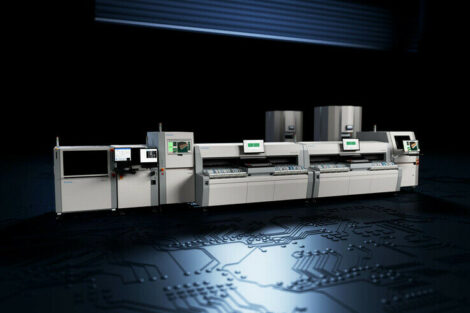Slowly, AOI equipment will get a central function as an inspection tool as well as for process improvements. Equipment supplier Omron has been listening to customers‘ requirements for AOI systems in order to identify defects accurately, scan multiple barcodes to increase output and efficiency by quick and easy identification of the board at rework stage. A world-leading CEM, based in the Czech Republic, is using a system that uses color for highlighting defects.
Paul Burn, Omron Electronics Ltd
The need for „right first time“ production and reduced costs per line affect all manufacturers. Increased density and intense production leave no room for error, particularly when defects are found at the backend of the line. Inspection and verification needs to be in-line. Customers such as the mentioned contract electronics manufacturer are discovering that the perceived high cost of an AOI system can quickly pay for itself in reduced costs, quality, yield and production improvements, and the ability to win contracts due to the installation of leading-edge efficiencies for quality and reliability assurance.
QA solution
AOI will improve production and process engineering, allowing for a more efficient distribution of resources. It will impact several areas of a process, including: post-paste printing, post-component placement and post-wave or reflow soldering. And it needs to be done fast with ease-of-use and in-line.
The Omron VT-WIN system incorporates unique inspection benefits. Its patented color highlight technique works by using a fluorescent light source to project red, green and light blue onto the board assembly at different angles. The camera captures these colors as they reflect off the board’s surface, producing a two-dimensional image that conveys three-dimensional information. The use of color over standard gray-scale classification has resulted in significant gains in visual benefits. Traditional grayscale gives 256 shades of gray; but the average human eye is only capable of recognizing about 16 of these. The introduction of the tri-color system has increased the possible variants to 16.4 million which, of course, cannot all be differentiated by the eye, too, but allows the two-dimensional image to give far greater detail and gives depth visually to the image. This allows for the easy detection of solder defects, including: excess and missing solder, bridging, solder balls and non-wetting areas. The system also clearly identifies defects in component placement which incorporates polarity errors, missing components, bent leads, shifting, tombstoned and bill-boarded parts as well as lifted leads.
Omron’s exclusive color extraction process simplifies machine set-up and customization of the color highlight system. Using a graphic user interface (GUI), it allows the operator to set color values by pointing to a desired object and assigning a color with the click of the mouse. It is clear to even the uninformed operator and manager that a color extraction process must be infinitely easier to use.
Color versus grayscale
Interpreting production defects with the use of color is simple to program and understand. It is not possible for the human eye and mind to detect and interpret shades of gray so easily. The ability to generate inspection programs off-line while the machine is still running has meant that downtime can now be avoided. Manufacturers can plan and create new jobs in advance and when the product is loaded ready for assembly, the correct program can be simply uploaded either manually, or can be triggered by a barcode scan.
In-line barcoding
Rework needs a reference point. The ability to store, scan and rework on the correct board is essential. Omron has been working with one of the world’s leading CEMs with facilities in Central Europe. The company successfully used VT-WIN equipment in its UK facility, and then the system was sent to the facility in the Czech Republic for integration into the first production line. The company ordered a machine with a 50mm height clearance between board and camera to accommodate connectors, so-ckets, etc. on their complex motherboards, and the need for at least 50mm clearance is essential. After extensive evaluation, a second system was sent to this facility. And in the meantime, four more units have been ordered for the UK plants.
Once installed, the customer made clear the need for the system to program and inspect multiple barcodes (nine in this case) on unbroken PCBs. A solution was found which was able to cope with different barcode types and formats. The board is identified and data exported to a PC, which was networked to the main database. Full traceability throughout with the risk of the wrong board being reworked is eliminated, and the ability to track all boards at every stage has allowed the user to increase production yields. All data is stored using standard program language, thus allowing the system to be networked at all levels, not just in the manufacturing area. This increased versatility allows full integration of data, and information can be quickly collated with regards to batches, rework operators or any number of other variables.
AOI – the hub of an assembly line
The installation of AOI equipment will be as much a part of any SMT production line as a screen printer or pick-and-place machine. The benefits are now apparent and cost reductions achieved over a period are obvious. But how does a user get more out of his investment?
For example, the VT-WIN will provide data analysis for line performance in real-time and not just single board assemb-ly performance. The need to merge information and identify manufacturing trends based on stored AOI data is now available. The AOI investment will provide a powerful statistical process control (SPC) and quality tool. The AOI equipment can be linked to the factory system, for example, for planning, QC, MRP and even invoice generation. Omron’s perspective of AOI is that reliable, fast and in-line 100% inspection and verification of SMT assembly is just the start – watch this space.
Zusammenfassung
Noch arbeiten die meisten AOI-Systeme auf monochromer Basis mit Grauskala, wobei von den üblichen 256 Schattierungen (8 Bit Auflösung), das Auge circa 16 Abstufungen zumeist klar erkennt. Omron setzt auf ein mit den drei Grundfarben Rot, Grün und Blau arbeitendes Highlighting-System. Es sorgt dafür, daß ein 2D-Bild wesentlich mehr Informationen über den inspizierten Boardbereich vermittelt.
Résumé
La plupart des systèmes AOI fonctionnent toujours sur une base monochrome avec échelle de gris, l’œil reconnaissant clairement environ 16 nuances sur 256 (résolution de 8 bits). Omron fait appel à un système à haute luminosité fonctionnant avec les trois couleurs fondamentales rouge, vert et bleu. Il fait en sorte qu’une image en 2D transmette considérablement plus d’informations sur la partie inspectée du circuit.
Sommario
La maggior parte dei sistemi AOI funzionano ancora su base monocromatica con scala di grigio, tenendo in considerazione che delle comuni 256 sfumature (con risoluzione di 8 bit), l’occhio riesce a riconoscerne in maniera chiara circa 16. La Omron punta su di un sistema Highlighting funzionante con i tre colori principali rosso, verde e blu. Questo sistema fa sì che un’immagine 2D contenga molte più informazioni sulla zona board ispezionata.
Share:










